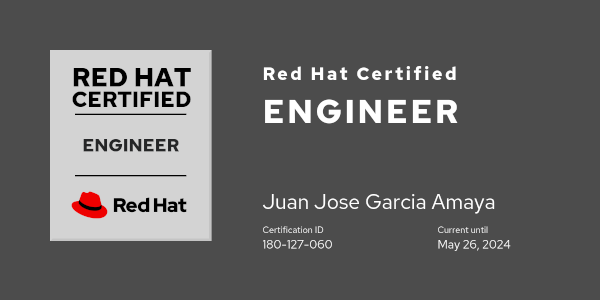I did it, I got the RHCE
I did it, I’ve passed the EX294 exam and got my RHCE certification.
I can’t disclose any information regarding the exam, but there is some public information at Red Hat’s EX294 page, and yes, I can confirm the information there is real.
This hands-on, practical exam requires you to use Red Hat Ansible Engine to perform real-world tasks. You will be provided with multiple systems and will be required to install and configure Ansible Engine and then use it to perform standard system administration tasks similar to what you would do on the job.
It’s true, but it isn’t like having your worst customer asking to do a lot of tasks, because the tasks are going to be well defined, but don’t fall asleep, there are a lot of them and the deadline is fixed.
Internet access is not provided during the exam, and you will not be permitted to bring any hard copy or electronic documentation into the exam. This prohibition includes notes, books, or any other materials. For most exams, the documentation that ships with the product is available during the exam.
ansible-doc and docs.ansible.com will be your (only) friends, get used to them, in both cases there are a lot of examples, so take advantage of them.
Downloading roles from Galaxy and use them is amongst the exam objectives, you have to be familiar with it and practice how to get information about how to use a downloaded role which you haven’t used before, just in case.
Also have in mind what comes enabled by default on a RHEL8 system, because it will be the OS used on the exam, take advantage of the free licenses available at Red Hat’s developers network and start practicing on it. For instance, you can be requested to deploy a specific network service, you have to be aware of SELinux and Firewalld despite not being specifically requested to be configured, but your service has to work and it could mean changing some boolean, context or opening a port on the firewall.
As a general advice, for this and any other practical exam, read the assignments carefully, all of them, may be some tasks don’t need to be on an specific order, and you can have experience on some, think about doing them first and ensuring a minimum score at least. I didn’t read all of them and struggled to get all done, knowing there were several tasks left but not knowing if they were easy or hard, added more pressure. You are not going to get extra points for any ornament, so do exactly as requested and don’t waste time.
Also it’s obvious you aren’t going to have your pc or laptop if you go to an examination center, so be ready to adapt to a new keyboard and screen. Doing the exam from home require booting from an usb drive which puts your PC in kiosk mode, but also some limitations like using wired keyboard and mouse, only one screen and a wired webcam will be required. You can check all the details at Setting up for your Red Hat remote exam: Things you need to do first page on Red Hat’s blog.
Remember this is certification for IT professionals who already have the RHCSA certification, so you are expected to be familiar with every topic on RHCSA certification, but this time through ansible playbooks. Reading a book or two can give you the necessary knowledge, but you can only get fluent with ansible using it again and again. So use it at every opportunity you have at work and also practice at home with exercises from training websites or doing the tasks you don’t usually do at work.
